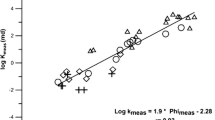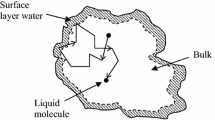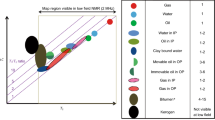Abstract
Measuring time constants in multi-exponential decay phenomena is crucial in many areas of knowledge. However, besides the inherent difficulties to the mathematical structure of the problem analysis, noisy experimental data can make the task considerably difficult. One important example is nuclear magnetic resonance (NMR) logging data obtained from measurements of water and hydrocarbons in porous rocks from oil fields. To minimize the uncertainties, it is important to design experiments under controlled conditions. In this paper, we report a systematic study of high (500 MHz) and low (15 MHz)-field NMR \(T_2\) relaxation times performed on artificial sintered sand-glass samples saturated with water. Porosity and permeability were controlled by selecting the range of grains, and then applying a specific sintering temperature protocol to produce samples with different porous sizes, constant porosity, but varying permeability. The structure of porous was verified by microtomography and scanning electron microscopy techniques. Porosity and permeability were measured, respectively, by the free-gas expansion and steady-state methods. We analyze the NMR data using three different approaches: (1) Laplace inversion with optimized regularization based on measured noise level, (2) bi-exponential, and (3) q-exponential nonlinear least-squares. Upon a careful measurement protocol, we report that all methods yield essentially similar \(T_{2}\) distributions.






Similar content being viewed by others
Notes
Actually, two surface relaxativities are presented: one relating to longitudinal relaxation on the surface and another to transversal process.
A porous sample with permeability equal to 1 Darcy allows a flow of \(1~{\text {cm}}^{3}/{\text {s}}\) of a fluid with viscosity of 1 mPa s under a pressure gradient of 1 atm/cm acting across an area of 1 cm\(^{2}\).
The residue of regularized solutions as a function of the regularization coefficient, even for the nonnegatively constrained problem considered here, is usually non-decreasing.
References
K.-J. Dunn, D.J. Bergman, G.A. LaTorraca, Nuclear Magnetic Resonance: Petrophysical and Logging Applications, vol. 32 (Elsevier, Amsterdam, 2002), p. 14
A.A. Behroozmand, K. Keating, E. Auken, Surv. Geophys. 36(1), 27–85 (2015)
B. Cowan, Nuclear Magnetic Resonance and Relaxation (Cambridge University Press, Cambridge, 2005)
A.A. Istratov, O.F. Vyvenko, Rev. Sci. Instrum. 70(2), 1233–1257 (1999)
K.P. Whittall, A.L. MacKay, J. Magn. Reson. 84(1), 134–152 (1989)
S. Davies, K.J. Packer, J. Appl. Phys. 67(6), 3163–3170 (1990)
M. Bertero, C. De Mol, E.R. Pike, Inverse Probl. 1(4), 301 (1985)
S. Ryu, in Proceedings of the SPWLA 50th Annual Logging Symposium of the Society of Petrophysicists and Well-Log Analysts (The Woodlands, Texas, USA, 21–24 June 2009) Document ID SPWLA-2009-30354
E. Grunewald, R. Knight, Geophysics 74(6), E215–E221 (2009)
H.C. Torrey, Phys. Rev. 104(3), 563 (1956)
F. Bloch, Phys. Rev. 83(5), 1062 (1951)
Stephen D. Senturia, J.D. Robinson, Soc. Petrol. Eng. J. 10(03), 237–244 (1970)
H.C. Torrey, Phys. Rev. Lett. 3(9), 418 (1959)
M.H. Cohen, K.S. Mendelson, J. Appl. Phys. 53(2), 1127–1135 (1982)
S. Godefroy, J.-P. Korb, M. Fleury, R. G. Bryant, Phys. Rev. E 64(2), 021605 (2001)
K.R. Brownstein, C.E. Tarr, J. Magn. Reson. 26(1), 17–24 (1977)
K.R. Brownstein, C.E. Tarr, Phys. Rev. A 19(6), 2446 (1979)
M.D. Correia, J. Magn. Reson. 244, 12–17 (2014)
W.E. Kenyon, SPE Form. Eval. 3(03), 622–636 (1988)
M.M. Labani, J. Pet. Sci. Eng. 112, 7–16 (2013)
S.F. Usman Ahmed, G.R.Coates Crary, J. Pet. Technol. 43(05), 578–587 (1991)
C.P. Slichter, Principles of Magnetic Resonance, vol. 1 (Springer Science and Business Media, New York, 2013)
Mario Bertero, Christine De Mol, Edward Roy Pike, Inverse Probl. 4(3), 573 (1988)
I. Foley, S.A. Farooqui, R.L. Kleinberg, J. Magn. Reson. Ser. A 123(1), 95–104 (1996)
M.D. Hürlimann, J. Magn. Reson. 131(2), 232–240 (1998)
T.R. Bryar, C.J. Daughney, R.J. Knight, J. Magn. Reson. 142(1), 74–85 (2000)
L. R. Stingaciu, A. Pohlmeier, P. Blümler, L. Weihermüller, D. van Dusschoten, S. Stapf, H. Vereecken, Water Resour. Res. 45(8), 8412 (2009)
S. Muncaci, I. Ardelean, Appl. Magn. Reson. 44(7), 837–848 (2013)
Acknowledgements
We are grateful to technicians and researchers of CENPES/PETROBRAS laboratories for the microtomography images, porosity and permeability measurements. We also would like to thank E.H.C.P. Sinnecker and J. P. Sinnecker for the susceptibility measurements. This work was supported by CAPES, CNPQ, and PETROBRAS, Project 2015/00275-5.
Author information
Authors and Affiliations
Corresponding author
Rights and permissions
About this article
Cite this article
Chencarek, B., Nascimento, M.S., Souza, A.M. et al. Multi-exponential Analysis of Water NMR Spin–Spin Relaxation in Porosity/Permeability-Controlled Sintered Glass. Appl Magn Reson 50, 211–225 (2019). https://doi.org/10.1007/s00723-018-1050-x
Received:
Revised:
Published:
Issue Date:
DOI: https://doi.org/10.1007/s00723-018-1050-x




